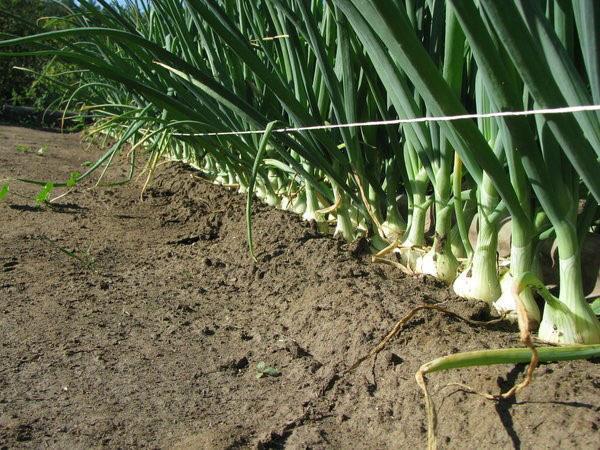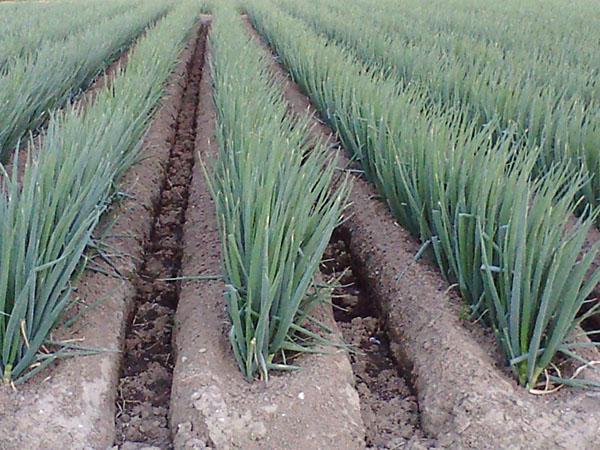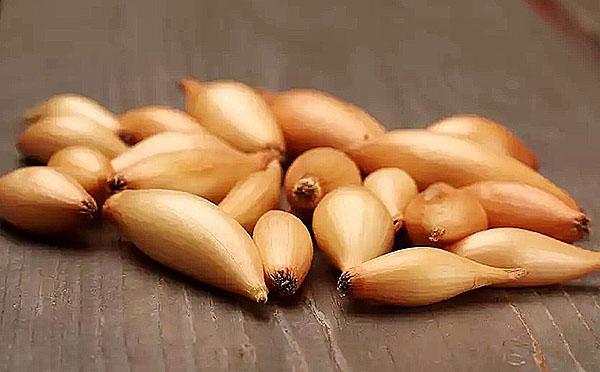Growing onions using Chinese technology - the secrets of a rich harvest
 Growing onions using Chinese technology is a little-known technique. It consists in the fact that the planting material is sown not on even beds, but on the ridges, and then large bulbs develop open. The method is gradually gaining popularity due to a number of advantages. According to reviews, the plants show higher yields with minimal labor costs. The Chinese technique can be applied to all types of onions, outdoors and in greenhouses.
Growing onions using Chinese technology is a little-known technique. It consists in the fact that the planting material is sown not on even beds, but on the ridges, and then large bulbs develop open. The method is gradually gaining popularity due to a number of advantages. According to reviews, the plants show higher yields with minimal labor costs. The Chinese technique can be applied to all types of onions, outdoors and in greenhouses.
The essence and advantages of the method

The method of growing onions according to Chinese technology has a number of advantages over the traditional method:
- especially large bulbs - it is especially easy for them to grow when open;
- resistance to fungal microflora due to good illumination and ventilation of underground parts of the plant;
- reduction in time spent on care, including loosening and weed control;
- saving fertilizers - they remain in the soil and are washed out less.
Onion fly protection is one of the main advantages of the Chinese way of growing. The larvae of this pest are dangerous for onions. They multiply in the soil, and during the period of their release the bulbs according to the Chinese technology are already open, so the harvest remains safe.
Preparing and sowing onions
 The best way to propagate onions in temperate climates remains set. These are small bulbs grown from onion seeds. Such onions are not used for food. Before planting in the ground, they must be carefully sorted out. Dry, damaged bulbs, as well as those that show signs of rot or fungus, must be separated and discarded.
The best way to propagate onions in temperate climates remains set. These are small bulbs grown from onion seeds. Such onions are not used for food. Before planting in the ground, they must be carefully sorted out. Dry, damaged bulbs, as well as those that show signs of rot or fungus, must be separated and discarded.
To obtain the maximum germination rates, the planting material should be pre-prepared. The procedure consists of several stages:
- the first heating - 10-14 days before sowing, the bulbs are spread on a battery (in spring) or on a hot sunny area (in summer);
- the next stage is cleaning the seed from the husk, while it is important not to damage the growth zone;
- the final stage - keeping the material in warm water (at least 40 degrees) for 2 days to activate vegetative processes.
Before planting onions, the soil is fertilized. This culture responds positively to the application of mineral and organic fertilizers. The first procedure is recommended to be carried out in the fall: 1 spoon will be needed for 1 square meter of soil superphosphate and nitroammophoska, as well as 2 tablespoons of dolomite flour. Immediately before planting, the soil is dug up with the addition of organic fertilizers (manure), and then uniform sides of 15 cm are formed, the distance between which is 30 cm.
In order for the onion to grow large and healthy, it is important to choose the right beds for planting it. Those on which such crops were found last year are optimal: pumpkin, zucchini, tomatoes, cucumbers or white cabbage.
Sowing dates
 Onion sets may vary in size.Individual bulbs can reach from a few mm to 4 cm, and it is important to correctly sort the planting material.
Onion sets may vary in size.Individual bulbs can reach from a few mm to 4 cm, and it is important to correctly sort the planting material.
Depending on this indicator, there are 4 main categories of sets:
- up to 1 cm in diameter - optimal for planting in winter;
- from 1 to 1.5 cm - suitable for planting in April;
- up to 2 cm - planted in the first half of May;
- 2 to 4 cm - set aside for summer plantings on feathers, as well as for growing in pots.
Planting onions in Chinese is carried out in 2 stages. The first falls on the second half of April, when the air temperature stably remains at 5 degrees. The second planting takes place in May. Initially, the second category is used, and the larger bulbs from the third category are left for May planting. They are placed in the ground at the top of the ridge, and the ground around them is slightly compacted.
Care rules
 When growing onions using Chinese technology, caring for them is minimized. The first watering is carried out immediately after planting, and then it is enough just to maintain the optimum soil moisture. In the presence of precipitation, there is no need for additional irrigation. Weeding is also unnecessary, as the root system of the bulbs develops quickly and the weeds cannot compete.
When growing onions using Chinese technology, caring for them is minimized. The first watering is carried out immediately after planting, and then it is enough just to maintain the optimum soil moisture. In the presence of precipitation, there is no need for additional irrigation. Weeding is also unnecessary, as the root system of the bulbs develops quickly and the weeds cannot compete.
It is recommended to apply fertilizers three times a season:
- in May - organic dressings (a mullein diluted with water 1:10 is suitable);
- in June - complex mineral fertilizers (phosphate, potash, nitrate);
- at the start of the formation of turnips - potassium-phosphorus fertilizing.
In mid-June, you can carefully remove the top layer of soil so that the bulb is on the surface. In the future, the process will continue on its own. A month before harvesting, watering must be stopped and at the same time loosened the soil. It is important to dry the bulbs before storing to prevent the growth of mold microorganisms.
The Chinese way of growing onions is gaining popularity. This technique saves time and reduces the need for fertilizing and weeding. The harvest is large and healthy, even on insufficiently fertile soils.